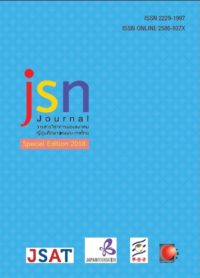คิทเช่น...เป็นมากกว่าห้องครัวในนวนิยายเรื่อง คิทเช่น
Main Article Content
บทคัดย่อ
นวนิยายเรื่อง คิทเช่น เป็นนวนิยายซึ่งแต่งโดยโยะฌิโมะโตะ บะนะนะ นักเขียนหญิงชาวญี่ปุ่น เนื้อเรื่องมุ่งนำเสนอการค้นหาความหมายของชีวิตของหญิงสาวคนหนึ่งที่สูญเสียสมาชิกในครอบครัวไปจนหมด เธอมีชีวิตอยู่อย่างโดดเดี่ยว อ้างว้างและสิ้นหวัง แต่เธอสามารถพลิกฟื้นกลับมามีชีวิตใหม่ได้อีกครั้งด้วยความรักที่ได้รับจากคนแปลกหน้า
บทความนี้มุ่งศึกษาความสำคัญของห้องครัวที่มีความหมายมากกว่าห้องครัว โดยมองผ่านมุมมองเรื่องพื้นที่ เนื่องจากการศึกษาเรื่องพื้นที่ในวรรณกรรมนั้นเป็นองค์ประกอบสำคัญที่ขาดไม่ได้ พื้นที่ไม่ได้เป็นเพียงฉากในเรื่องเท่านั้น หากแต่มีความสัมพันธ์ต่อเนื้อเรื่องและมีอิทธิพลต่อพฤติกรรมของตัวละครที่อยู่ในพื้นที่นั้น ๆ การศึกษาเรื่องพื้นที่ห้องครัวจะช่วยให้เข้าใจบริบทของพฤติกรรมตัวละครเอกมากขึ้น และช่วยให้ผู้อ่านตระหนักถึงความสำคัญของพื้นที่ห้องครัวที่มีผลต่อพฤติกรรมของตัวละครในเรื่อง อีกทั้งยังช่วยเพิ่มอรรถรสให้ผู้อ่านได้รับรู้เรื่องราวต่าง ๆ ได้ดียิ่งขึ้น ผลการศึกษาพบว่า 1) พื้นที่ห้องครัวส่งผลต่อพฤติกรรมของมิกะเงะตัวละครเอกในเรื่อง เนื่องจากเป็นพื้นที่ของครอบครัว พื้นที่แห่งความทรงจำและพื้นที่เยียวยาจิตใจ 2) พื้นที่ห้องครัวทำให้ตัวละครได้เรียนรู้เรื่องชีวิตและความตาย 3) พื้นที่ห้องครัวทำให้เข้าใจความสัมพันธ์ของพื้นที่กับตัวละครในเรื่องมากขึ้น
Article Details
ข้อความและข้อคิดเห็นต่างๆ ในบทความเป็นของผู้เขียนบทความนั้นๆ ไม่ใช่ความเห็นของกองบรรณาธิการหรือของวารสาร jsn Journal
เอกสารอ้างอิง
เดือนเต็ม กฤษดาธานนท์. (2557). เอกสารประสอบการสอนรายวิชา 2223482 นวนิยายญี่ปุ่นร่วมสมัยภาคการศึกษาปลาย / 2557, สาขาวิชาภาษาญี่ปุ่น ภาควิชาภาษาตะวันออก คณะอักษรศาสตร์ จุฬาลงกรณ์มหาวิทยาลัย.
ธาริตา อินทนาม. (2555). พื้นที่กับการสร้างอัตลักษณ์ของชาวแอฟริกันอเมริกันในนวนิยายเรื่องซองออฟโซโลมอนของโทนีมอริสัน. วารสารศิลปศาสตร์ ปีที่ 12 ฉบับที่ 1. หน้า 57-89.
มณฑา พิมพ์ทอง. (2547). มองสังคมญี่ปุ่นหลังสงครามโลกครั้งที่ 2 จากวรรณกรรม. กรุงเทพฯ : โครงการเผยแพร่ผลงานวิชาการคณะอักษรศาสตร์ จุฬาลงกรณ์มหาวิทยาลัย.
วัลยา วิวัฒน์ศร. (2541). มิติสถานที่ในนวนิยายของฟร็องซัวส์โมริยัค. กรุงเทพฯ : โครงการตําราคณะอักษรศาสตร์ จุฬาลงกรณ์มหาวิทยาลัย.
สหโรจน์ กิตติมหาเจริญ. (2554). “พื้นที่” ในเรื่องสั้นดรรชนีนางของอิงอร. การประชุมทางวิชาการระดับชาติ“ภาษาวรรณคดีไทยและการสอนภาษาไทยในฐานะภาษาต่างประเทศ : การเรียนรู้และสร้างสรรค์จากสังคมไทยสู่สังคมโลก”. หน้า 310-324.
สุรภีพรรณ ฉัตราภรณ์. (2550). อาหารอารมณ์และอํานาจของสตรีในวรรณกรรมร่อยแก้วตะวันตกร่วมสมัย. กรุงเทพฯ : โครงการเผยแพร่ผลงานวิชาการคณะอักษรศาสตร์ จุฬาลงกรณ์มหาวิทยาลัย.
อัจฉรา เหมวรางค์กูล. (2555). ตัวละครเอกหญิงในนวนิยายเรื่องคิทเช่น. เอกสารหลังการประชุมวิชาการระดับชาติเครือข่ายญี่ปุ่นศึกษาในประเทศไทยครั้งที่ 5 (มนุษยศาสตร์)กรุงเทพฯ : โครงการเครือข่ายญี่ปุ่นศึกษาในประเทศไทย. หน้า 287-299.
อัจฉรา เหมวรางค์กูล. (2555). ตัวละครเอกหญิงในนวนิยายของโยะฌิโมะโตะบะนะนะ. วิทยานิพนธ์ปริญญามหาบัณฑิต สาขาวิชาภาษาญี่ปุ่น ภาควิชาภาษาตะวันออก คณะอักษรศาสตร์ จุฬาลงกรณ์มหาวิทยาลัย.
Murakami Fuminobu. (2005). Postmodern, feminist and postcolonial currents in contemporary Japanese culture: A reading of Murakami Haruki, Yoshimoto Banana, Yoshimoto Takaaki and Karatani Kojin. London and New York: Routledge.
木股知史 (1999)『吉本ばなな イエローページ』荒地出版社
斉藤金司 (1990) 吉本ばなな『キッチン』を読む 主潮 第18号
関井光男 (2006) 家族戦争・人口問題と少子化老齢化の社会-吉本ばなな『キッチン』国文学 第51巻第5号
西尾実、岩淵悦太郎、水谷静夫 (1983)『岩波国語辞典 第3版』岩波書店
原亜由美 (2013) よしもとばなな「キッチン」が大島弓子作品から受け継いだもの-「バナナブレッドのプディング」と「夢のキッチン」-歴史文化社会論講座紀要 第10号
吉本ばなな (2002)『キッチン』新潮社


